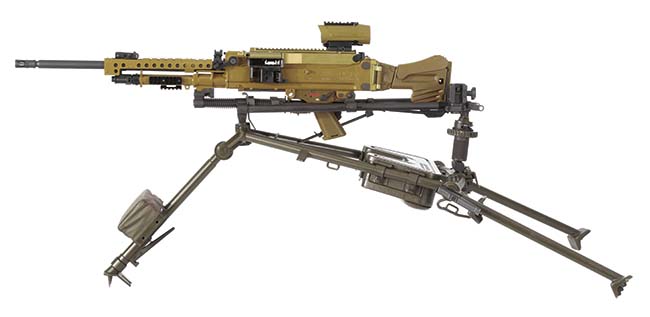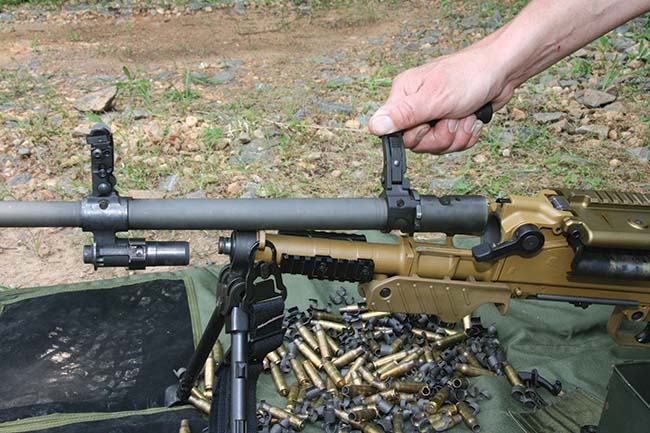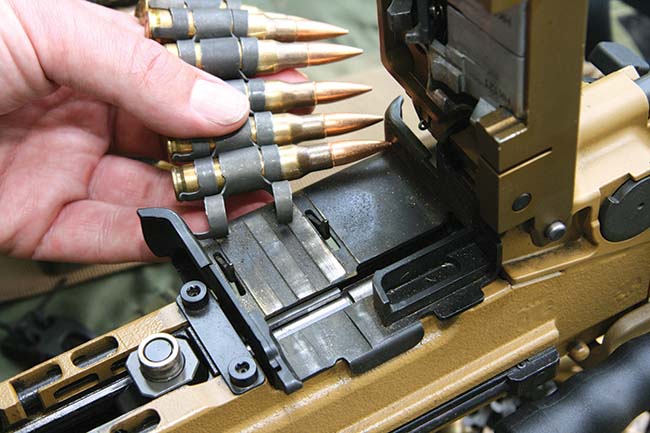ABOVE: A useful comparison of similarities between the 7.62 NATO caliber HK121/MG5 in front, with its predecessor, the 5.56mm MG4 in the background. The 22 pound/9.9 kg MG5 pictured is the A2 (Infantry Version) with short 18 in./460 mm barrel, heat protection shield, Grip Pod, 120 round belt soft pouch, adjustable mechanical rear sight and foldable telescoping stock with cheek rest. The 17 pound/7.7 kg MG4 KE has a short 14.6 in./370 mm barrel, Trijicon ACOG sight on Picatinny rail, folding bipod, and belt drum. Commonality of design ensures quick transition of gunner skills from one to the other due to the same operating system, quick change barrels, and ambidextrous safety. (H&K)
Developed as the successor of the German military’s 7.62, MG3 general purpose machine gun, this modern, 21st century design was originally known as the HK121. In June 2013, it was selected by the German Army and rechristened the MG5. The MG5 opens a new era of universal belt-fed 7.62 x 51mm weapons.” (HK promotional information)
After more than 70 years of distinguished service in Germany, the WW2 era MG42, which became the MG3 in postwar Germany, had been left behind by more versatile and combat-effective designs.

While Rheinmetall’s old war horse has many admirable traits such as manufacturing efficiency and operational simplicity, its heavy and ungainly configuration, extreme 1,000+ rpm rate of fire, inability to accommodate modern, supplemental sighting systems, and lack of adaptability to multiple roles, put it at a disadvantage vs. some other general purpose machine guns.
Perhaps most prominent among these is FN’s superlative MAG-58, in service with the majority of Germany’s NATO partners including the U.S. with its M240 series.
While no lighter than the old German gun, the Belgian one has distinct advantages in somewhat modular adaptability from infantry use to vehicles, air and watercraft, armor coaxial and remote controlled turrets. So, why not just replace the MG3 with the MAG-58? Simply put, the German solution was to design and build an even better system.
“Infanterist der Zukunft” (Infantry Soldier of the Future)
The genesis of the resulting HK121/MG5 from the native firm Heckler & Koch came with the German Bundeswehr’s (Armed Forces) “Infantry Soldier of the Future” program, a comprehensive modernization effort concurrent with similar initiatives in the U.S. and other NATO partners.

Striding past another FN design, the commonly fielded MINIMI which is best known as the M249 in U.S. service, HK‘s innovative 5.56mm gun won the competition for Germany’s SAW (squad automatic weapon) role, designated MG4 in logical nomenclature progression. Fielded in 2004 and soon in vicious firefights in Afghanistan, the MG4’s reported reliability, accuracy, soldier-friendliness, and modular adaptability provided additional validation. But with two notable exceptions:
More powerful 7.62 x 51mm NATO ammo was needed for the longer range engagements that characterized the fight against Taliban
insurgents.
The old MG3 was good, but not good enough.
Information supplied to SADJ from HK states 2006 as the start of design work on what would eventually become the MG5. We’re not alone in speculating that its mist-shrouded origins came much earlier; perhaps even during the “Soldier of the Future” effort. Either way, the developmental HK121 is clearly derived from its 5.56mm brother.

Aside from heavier caliber and necessary beefing up of the receiver from the usual stamped metal on the predecessor to rock solid steel castings, the little and big guns are almost the same in form and function. This certainly validates the MG4’s basic design, manufacturing aspects and operational utility and is important in many ways on the end-user side including ease of soldier transition from one to the other as well as armorer training.
But maybe most significant is the new gun’s building block modularity for the widest variety of combat applications and how reconfiguring is done at the operator level; simply, quickly and no tools are needed.

Anatomy of the HK121/MG5
A tour of the gun from muzzle to butt plate facilitates detailed observations on how and why HK’s design team has created a superior entry in the GPMG (general purpose machine gun) field.
While the gun starring in the exclusive live fire session for Small Arms Defense Journal is number 0031 of 65 in the proof sample/pre-production run to support more detailed Bundeswehr T & E, we’re told that only small changes have been made since then. As such, we offer the following from both direct observation and additional information provided by HK.
The birdcage flash suppressor is optimally “tuned” to efficiently minimize visual signature at night. It tips all three quick-change barrels of various lengths and properties that are provided for different applications. A quick-coupling, very efficient suppressor is seen in the official HK video, most likely available on special order.

All have integral front sights that fold down out of the way, sturdy, adjustable gas blocks, folding handles that are essential to the quick change capability, and barrel extension with fully enclosed
cartridge chamber.
They boast HK’s world-renowned cold hammer forged rifling and exceptionally strong metallurgy so they won’t rupture when the bore is obstructed – even with steel core projectiles.
The longest is a 663mm/26 in. “heavy barrel,” delivering longest range accuracy and extra heat absorption when installed in remote controlled turrets or coaxial with cannon caliber guns in armored vehicles. It can also be a useful component of the “Universal” model when tripod mounted. Two others are provided, 550mm/21.6 in. and 460mm/18 in., giving operators their choice best suited to mission and circumstances. We’ve seen these as both conventionally round or “fluted” for a bit less weight and a bit more cooling surface.

The post type front sight is housed in a fold-down mount. Underneath, the gas block mates with a choice of two gas cylinders, one smooth and another with three short lengths of Picatinny rail for accessory mounting. Both have front sling
attachment points.
Integral with the gas block is another very important feature of the gun; a three-position gas regulator that is instantly adjustable using the base of a cartridge. With the barrel pointing to the gunner’s left, note the position of the leaf spring lock in one of three index holes in the front of the gas block. Top position is 800 rpm, middle is 700 and bottom is 600.
Length-adjustable bipods in sturdy steel or lighter aluminum attach with a collar around the gas cylinder and fold up to lock out of the way inside an ergonomic polymer hand guard. A perforated heat shield is available to protect against hot barrel burns.
A mounting adaptor for the underside front of the receiver provides a rigid attachment point for a Grip Pod vertical foregrip or to interface with adaptors for standard German tripods and vehicle mounts.
The spring loaded barrel change locking lever is on the left side of the receiver front and the barrel handle is normally kept in folded down position on the right side. A quick one-two motion allows instant removal: Push the locking lever down with one hand and lift the handle with the other. Slide the barrel forward to effortlessly uncouple it from the receiver and gas cylinder.

Good news here for highly stressed gunners in the middle of a firefight: the barrel can be removed and replaced with the bolt forward or backward. The cleverly designed bolt just rotates in its carrier to lock or unlock as needed.
Receiver Group
The receiver group is, of course, the most basic element of any gun, and the HK121/MG5’s is as sturdy as a bank vault. Departing from the commonly employed steel stampings and rejecting the century-old convention of riveted steel plates, HK’s engineers have produced an innovative solution to the conflicting tradeoffs of weight, durability, reliability, cost, etc.
SADJ’s written inquiry into specifics of the 121’s receiver and its fabrication was oddly sidestepped by HK for unspecified reasons, replying only: “Patented receiver,” and noting advantages of “stability, forming, easy structure, robustness, enormous lifetime.”

So let’s try to fill in the blanks with direct observation. It appears that the receiver is formed from two precision steel forgings. Some necessary machining operations are done to a steel insert and the halves are joined with “a
patented process.”
This novel arrangement produces a remarkably rigid and durable housing, giving it exceptional service life and solid barrel lock-up for accuracy in full auto fire out to the effective limits of its NATO
standard ammo.
A durable finish is then applied, available in matte black or the “RA8000 Green/Brown” as seen on the gun we fired.
A full length run of Picatinny rail is integral with the top cover that is sturdily hinged to the front of the receiver and locks securely in place at the back. Inside the cover we find the shuttling cartridge guide/feed pawls, driven by a hinged
camming track.
Though a seemingly conventional feed arrangement, it has been geometrically and mechanically optimized.
Combined with the pair of strong buffer/return springs acting on the bolt carrier, what HK calls a “two step shift feeding system” gives extraordinary belt pulling power.
We’re told that this “harmonized system” is capable of lifting a free hanging 250 round belt. This translates into super-reliable feeding in all situations, particularly when the gun is installed in vehicle or aircraft mounts for chute feeding from extra-large capacity ammo cans.
The top cover can be slammed closed with the bolt in any position without damage because of its spring loaded cam roller. It locks automatically and a prominent hinged hook is readily grabbed to unlock and lift it.
Feed trays are also modular components with specific adapters for various bags and boxes.
The receiver’s end block or backplate can be quickly removed by pulling two captive pins (send the bolt forward first to relieve spring tension). It has twin bolt
carrier guide rods with “tuned” coil springs as well as the interface for a handy selection of three different buttstocks and a set of spade grips.
Under the receiver is a spring loaded dust cover for the cartridge ejection port that pops open automatically when the bolt carrier moves.
Inside we find the mechanism itself, a skillful adaptation and improvement on various combat proven predecessors.

Bolt Carrier Group
The 121’s gas piston and pedestal type bolt carrier are joined as a single unit, an arrangement dating back to the Lewis Gun of WWI. This was carried forward in the WW2 German FG42 and the Vietnam-era U.S. M60.
But HK’s Research & Development team, led by Stefan Doll, has perfected the pedestal system by putting the bolt in a precision machined tunnel in the rectangular carrier. Instead of the arrangement on the FG42 (and the U.S. M60, by the way) of a camming track cut in the bolt body that turns it when the carrier runs back and forth, the 121’s bolt is turned to lock and unlock by angled bolt locking cuts inside the barrel extension.
Because the bolt itself rotates for locking and slides back and forth in its carrier tunnel, it couples and uncouples freely. This arrangement is the “secret” to being able to remove and replace the gun’s barrel when the bolt is forward or backward.
With the carrier group rushing forward under spring power when the trigger is pulled, the unlocked bolt is held fully extended by a protruding piece on the bolt body that has rotated into a corresponding notch on the right side of the bolt carrier.
When the whole carrier assembly moves forward, the bolt head enters the barrel extension and the bolt body turns counter clockwise to lock, freeing the protruding piece from its notch in the carrier. As the bolt body turns, the piece rotates upward and aligns with a long, lengthwise guide track on top of the carrier. The bolt body is now free to slide backward into
its tunnel.
Only in the carrier assembly’s fully forward position (bolt head securely locked in the barrel extension) can the head of the stationary firing pin hit the primer on a chambered cartridge.
On firing, a portion of propellant gas enters the gas block to move the piston, pushing the attached carrier rearward. Sufficient milliseconds of dwell time are built in for the detonated cartridge case to deflate before extraction. As the carrier moves back, the bolt head turns clockwise to uncouple from the barrel extension, extracting and ejecting the empty casing.
Twin “loops” toward the front of the carrier are for the two guide rods with coiled springs that slow rearward movement on recoil and provide a vigorous push for the feed cycle.
As previously mentioned, the feed camming roller sits atop the carrier and a there’s a prominent horizontal roller underneath that rides in channels machined in the upper part of the receiver. On both sides near the bottom of the carrier are rectangular bearing surfaces that slide in respective channels machined in the
receiver insert.

Arrestor notches on the bottom of the bolt carrier are an important safety feature that was previously developed for the MG4. These keep the bolt from accidentally running forward to chamber and fire a round if the operator’s hand slips off the charging handle.
The “T” shaped charging handle, by the way, is clearly derived from that of the MG42/MG3. Although a bit smaller, it still has plenty of grip surface and it’s friendly to heavily gloved hands.
Built into the carrier is what HK calls a “damper” that works to mitigate recoil forces. No details were provided on this mysterious contrivance that must be inside that plunger sticking out of the rear of the bolt carrier.
The very long gas piston, pinned to the bolt carrier, appears to be machined from stainless steel for corrosion resistance. As seen on the MAG58, it has an open slot where it nears the carrier to allow downward ejection of expended
cartridge cases.
Trigger Housing Group
Two trigger housings are available: a conventional one as seen on the test gun and a stubby one with solenoid actuated trigger and clever bolt-position sensor for mounted applications.
The standard grip is polymer in an ergonomic configuration. Its trigger guard is big enough for a gloved finger and proper setting of the ambidextrous fire control switch is readily noted by HK’s usual pictographs. Hidden inside is the clever sear arrangement facilitating the gun’s ability to be rendered SAFE no matter if the bolt is forward or backward.
On the Range
SADJ was invited by Robbie Reisdma of HK Defense and Jimmy White of Trijicon to observe and have a turn in an exclusive live fire demonstration at Crucible tactical training center in rural Stafford County, Virginia.
An important logistical obstacle was cleared by a generous amount of belted 7.62 NATO ball supplied by Dan Shea, who just happens to be closely aligned with SADJ’s publishing team.
White showed us how to perform the laser-ranged and short burst zeroing setup regimen on the highly capable Trijicon CCAS that was clamped atop Reidsma’s HK121. Then, firing from a prone, bipod-supported position, he sent more rounds downrange into a scaled-down metal silhouette for the equivalent of some 300 meters distance.
Although this 6 power, computerized smart sight’s best work is done at considerably longer range and particularly against moving targets, we got enough of a look to appreciate the benefits it provides for precision machine gunning – particularly when avoiding “collateral damage” of non-combatants.
Then, closer in for assault fire photos, Reidsma demonstrated the fine technique he learned the hard way in his years as a Marine Corps infantry NCO.
Our turn on the gun was not nearly as impressive, but enough to validate HK’s claims in promotional materials for handling and moderate recoil controllability. Recalling some trigger time not so long ago behind a bone-rattling MG42, the 121 experience was far more pleasant.
With the all-important live fire having been accomplished, we moved to a shady area nearby and went through the usual “show ‘n tell” for both the sight and the gun. More pictures, of course, as noted in these pages.
What’s Next?
Although HK and the Bundeswehr (German military) have tested the hell out of these guns and consistently found them quite worthy, final trials are ahead before full acceptance.
As this is being written in late summer 2014, first-production MG5s have just completed desert trials at the U.S. Army’s blisteringly hot Yuma Proving Ground. A contingent of German mechanized infantrymen and paras, many of whom are vets of combat in Afghanistan, have put the guns thru the wringer in both battle drills and endurance firing.
In order to avoid some of the bureaucratic purgatory from moving guns across the national borders of a notorious third-world country, tropical testing will take place in Hawaii, not at Yuma’s steaming jungle facility in Panama.
If all goes well and we see no reason why not as far as the guns are concerned – HK is on track toward receiving a reported $300 million contract for as many as 12,000 MG5s. This will allow gradual replacement of all remaining MG3s and other 7.62mm types in the inventory.
Homework Assignments
HK has a fast-paced, highly informative, ten minute video on the website of its German headquarters: www.heckler-koch.com, or on YouTube (search HK121).
The CCAS can be seen on YouTube in a short promotional video from Trijicon and a longer informational clip from Guns & Gear TV (search Trijicon CCAS).
(The SADJ Team extends special thanks to Robbie Reidsma of HKD and Andy Falcone of HK GMBH, Jimmy White of Trijicon, Crucible training center, and Dan Shea. Also to retired Major General Carroll Childers for keen observations through the lens of decades-long experience as a small arms engineer and user.)







